Every time I watch Citizen Kane, it just gets better and better. I am astounded each time by the bold visual style and am swept up in the brilliance of the story. Movies don't get much better than this. Sure it has flaws. No movie (or thing for that matter) is without flaws. But the good far outweighs the bad. If you are interested in some of the background about Citizen Kane, and its parallels with the real life of William Randolph Hearst, Wikipedia has an awesome article detailing many of the movie's visual triumphs and history. But let's get on with our discussion of the movie's composition.
I have picked out some screen shots that I felt typified some of the movie's mastery of vision.
_________________________________________
Deep Focus
This movie was groundbreaking in its use of deep focus. Many of the shots were done without any compositing tricks whatsoever. Others (matte shots) had do be put together either in camera or with a machine called an optical printer. 
Above we see Kane's butler in the foreground and Kane himself far in the background. Both are in focus. The below picture is clearly one of the images that has been pieced together since the foreground is in sharp focus, the background is also in focus, but the middle is oddly out of focus.
The effect that having the sleeping figure out of focus has is to underscore the insignificance felt by Susan Alexander who apparently has just tried to commit suicide.
_________________________________________
Cool Shots
There is an abundance of shots in the movie that really make you go "ooooh," but this one in particular has always been one that I have loved. 
It is Kane's broken snow globe at the beginning of the movie, and the action (nurse entering the room) is revealed in reflection on the convex broken glass.
This one is also amazing: 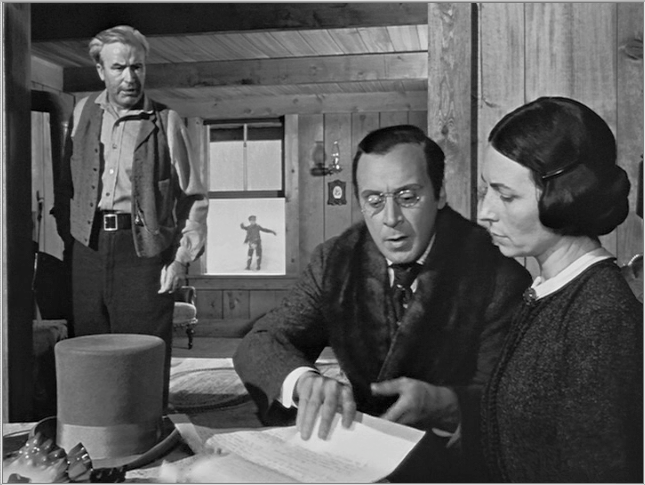
The shot begins with a boy playing the snow. Then the camera pulls back to reveal a mother at a window watching the boy. Then the camera pulls back even further and a scene plays out indoors as the boy continues to play outdoors completely unaware that a new life is being negotiated for him inside. This is all done in one take and everything from the extremely close foreground, to the distant boy in the background is perfectly in focus.
_________________________________________
And with regards to meaning...
Power Struggles
Look at the previous image again. Little boy Kane's central position denotes his central position in the discussion at hand. His size, on the other hand, underscores his lack of say in the matter. The divide between Pappa Kane and Mamma Kane (who sides with Thatcher) is present both literally in the story as well as visually in the shot.
The following shot shows Kane's lack of power once again, especially with regard to Thatcher, who appears largest in the image: This can be contrasted with the following two shots where a growing Kane gains equality with Thatcher:
This can be contrasted with the following two shots where a growing Kane gains equality with Thatcher: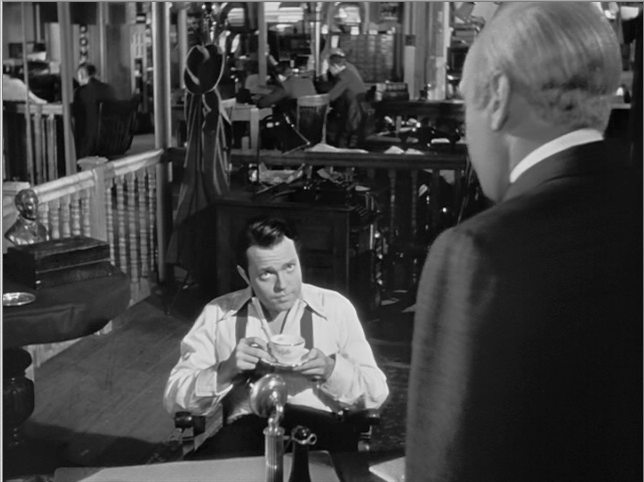

And finally a third shot where Kane gains his own power, and Thatcher is seated helpless on the left.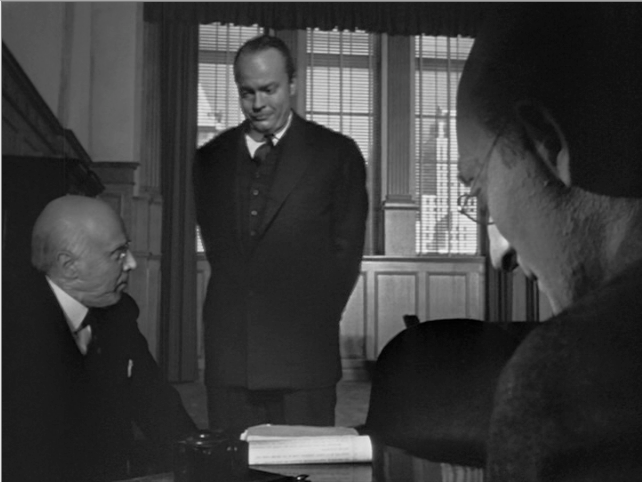
Kane was eventually overwhelmed by his own power. His outward self (the man of wealth, influence, and control) begins to overshadow here left at a political rally. Look at how massive this projected Kane is compared to the real Kane: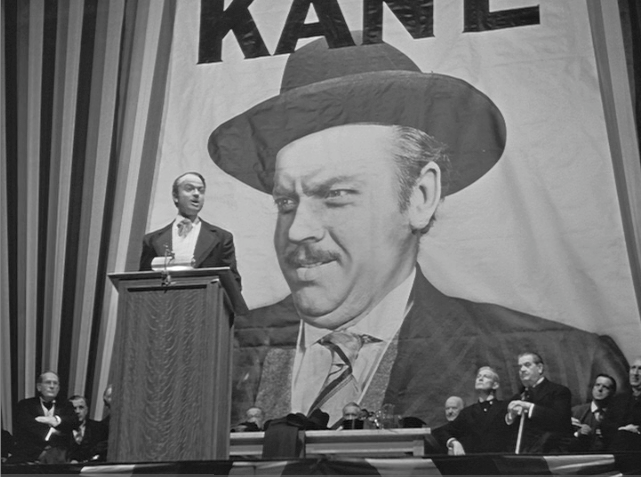
And below, you can see that he is completely overwhelmed by his palace -- a material symbol of his perceived social/monetary stature.
_________________________________________
Emotional Distance
Orson Welles used space between characters effectively to describe visually the distance felt between the characters emotionally. For instance, with Kane's first marriage. We see a montage of breakfasts over an extended time between the couple. In the first shot (below left) they are intimate and happy. By the last shot (below right) in the montage they are distant and not even speaking.
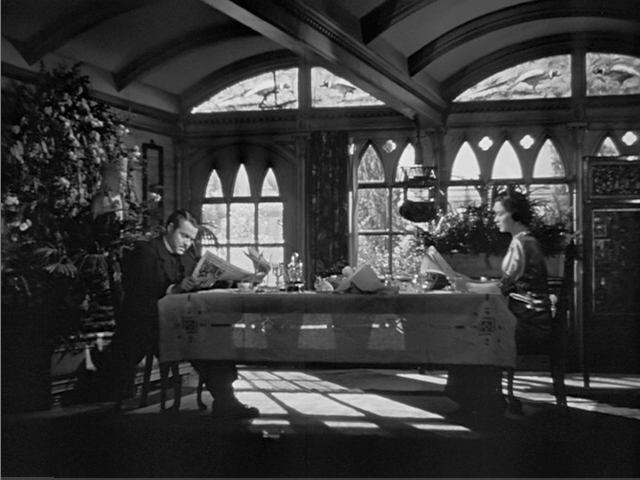
Kane's marriages went from bad to worse. With his second marriage, the distance between the couple is even greater. Below, Kane and Susan Alexander (wifey #2) have a "typical" conversation about inviting people over for a picnic.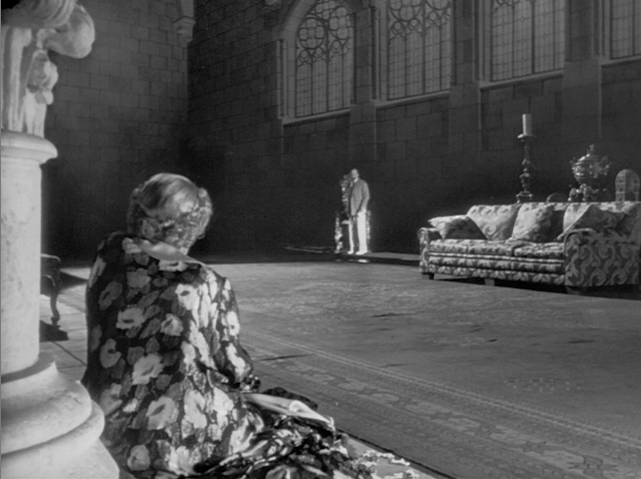
_________________________________________
An Enclosed World
Welles included the ceiling in many of his shots: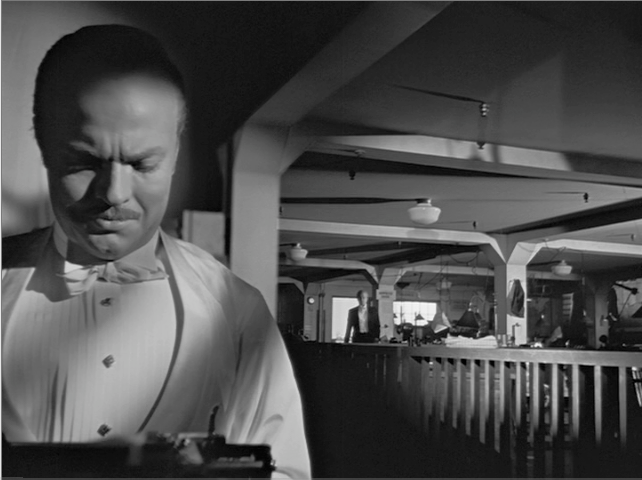
This was completely unheard of in 1941, but still rarely done today. The reason is because there is often no ceiling on production sets. This is where many of the lights hang and where the boom microphones hover. Welles gave us a world described in mostly low angle shots, where many of the characters (including our lead) towers over us, but where we also get to see the limitations (ceiling) above and psychology of that figure. The world closes in on Kane, and he longs to be free of that ceiling. Free of limits on his power. Or perhaps he longs to be free as he was playing in the snow as a boy.
_________________________________________
A Man, Divided
Near the end of his tale, and life, Kane walks alone but surrounded by himself. He is a multiplicity of perceptions about him. He is a group of personalities and fallacies he projects to the world. 
But there is no real Kane. The real Kane is lost. He is lost and he is broken. Shattered.
_________________________________________
Well those are some that I picked out for you. Let me know what you thought about the movie, and what jumped out at you visually. Tell me if you picked up on any meaning that was given to you visually, or if you saw something that made you go "oooooh."
Back to the full blog...
Monday, November 06, 2006
Composition -- Citizen Kane Discussion
Subscribe to:
Post Comments (Atom)

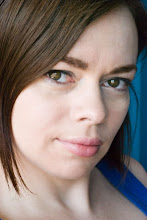
5 comments:
You listed my favorite shot of the whole movie: where the boy Kane is playing in the snow through the window while his family discusses what shall be done with him. It's a turning point in the plot and is the launching point of what will become of Kane.
Great job of analyzing these shots. Thanks. - Leo
My favorite part was that you called the "emotional distance", whitch also showed a flow of time. Just to add, the element that also demonstrated the emotional distance was clothes of the wife which started out as a light, bright and a little naked, but eventually became one tihgter, darker and almost completely covered the body.
The shot with Kane and Susan after the attempted suicide may not have been composited. Indeed, I think it was the result of Toland's usage of a tilt-shift lens, which yields exactly that sort of effect.
I loved your analysis otherwise.
My favorite shot in the film (not shown here) is the shot where Kane is destroying Susan's room, and comes in contact with the snow ball. Welles's reaction is simply stunning.
Post a Comment